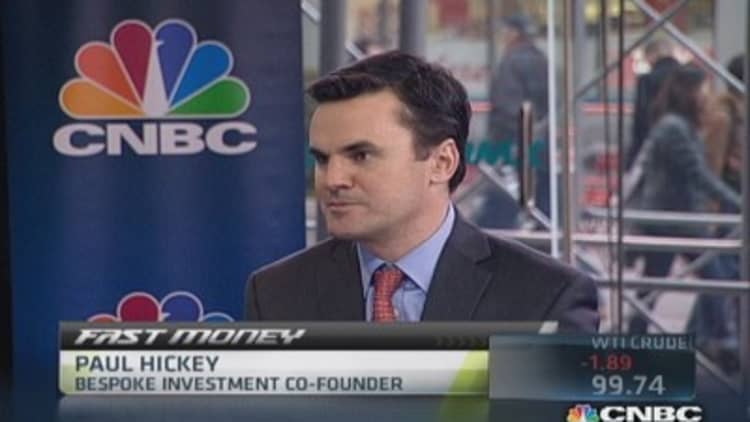Stocks are sniffing out a spring thaw, and private payroll data Wednesday should give some further clues as to whether the bounce back rally can continue.
Monthly auto sales Tuesday were surprisingly strong, reflecting pent up buying demand from the months of bad winter weather and also a willingness by consumers to spend on big-ticket items. Sales by the top five carmakers were up 5.7 percent to an annualized selling rate of 16.4 million vehicles, well above an expected 15.8 million rate and last year's pace of 15.6 million.
"Right now the market's betting on a rebound in the economy. We got it in car sales, and we barely got it in ISM," said Peter Boockvar, chief market analyst at Lindsey Group.
Read More

ISM manufacturing data Tuesday showed activity rising to a reading of 53.7 in March, from 53.2 in February, slightly lower than expectations. But the production index, within the report, rose more than 7 points to 55.9, and new orders climbed to 55.1 from 54.5. The employment index, however, slipped by more than a point to 51.1, the weakest since June.
Read MoreUS manufacturing continues steady march: Surveys
Traders have been looking ahead to the government's March jobs report Friday as a possible mile marker for the turning point from the winter weather effect. So, even though ADP is not well correlated with the jobs report, it is an important snapshot of private-sector hiring. Economists expect 203,000 private-sector jobs in the ADP report.
Friday's government employment report is expected to show the economy added 200,000 jobs, the most in four months, according to Thomson Reuters. The unemployment rate is expected to slip by one-tenth to 6.6 percent. Job growth had averaged about 200,000 most of last year, until the onset of severe winter weather in December.
Michael O'Rourke, chief market strategist at Jones Trading, said: "195,000-200,000—that would be a strong number if it comes through anywhere in there. I think we all expect the consistent trend to be somewhere between 175,000 and 225,000. I think that's where people expect us to be running at throughout 2014, and I think that's what people will benchmark off of."
O'Rourke said the risk to the market is if the jobs report and other data don't show the improvement investors are expecting.
Read MoreGartman: The 'one thing' I've learned in 40 years
Stocks rallied Tuesday against the backdrop of the better data, and the S&P 500 made a new high, its seventh of the year. The Dow jumped 74 to 16,532, while the S&P 500 added 13, closing at 1,885. The market typically does well in April, and it is the best month for the Dow most of the time.
The Dow has averaged a gain of 2.8 percent in April, over the past 20 years. April is also one of the best months for the S&P, which averaged an increase of 2.2 percent over the past 20 years.
Read More No fooling! April is the Dow's best month
"Any new high is generally significant because new highs, from a technical perspective, beget new highs. One of the problems with registering one on the first days of the month, is you usually have this whole new inflows coming in and it tends to be more technical and less fundamental," O'Rourke said. "It's positive but I'm personally still cautious."
O'Rourke said it's not clear whether the selling in momentum names is over. The IBB Nasdaq Biotech ETF was up more than 2 percent and is more than 5 percent higher in the last two sessions. The First Trust Dow Jones Internet Fund ETF FDN was also more than 2 percent higher, and SOCL, the Global X Social Media ETF was nearly 3 percent higher.
—By CNBC's Patti Domm. Follow her on Twitter @pattidomm.


